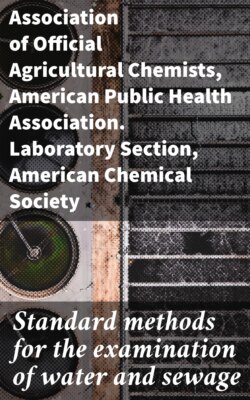Читать книгу Standard methods for the examination of water and sewage - Association of Official Agricultural Chemists - Страница 5
ОглавлениеQUANTITY REQUIRED FOR ANALYSIS.
The minimum quantity necessary for making the ordinary physical, chemical, and microscopical analyses of water or sewage is 2 liters; for the bacteriological examination, 100 cc. In special analyses larger quantities may be required.
BOTTLES.
The bottles for the collection of samples shall have glass stoppers, except when physical, mineral, or microscopical examinations only are to be made. Jugs or metal containers shall not be used.
Sample bottles shall be carefully cleansed each time before using. This may be done by treating with sulfuric acid and potassium bichromate, or with alkaline permanganate, followed by a mixture of oxalic and sulfuric acids, and by thoroughly rinsing with water and draining. The stoppers and necks of the bottles shall be protected from dirt by tying cloth, thick paper or tin foil over them.
For shipment bottles shall be packed in cases with a separate compartment for each bottle. Wooden boxes may be lined with corrugated fibre paper, felt, or similar substance, or provided with spring corner strips, to prevent breakage. Lined wicker baskets also may be used.
Bottles for bacteriological samples shall be sterilized as directed on page 98.
INTERVAL BEFORE ANALYSIS.
In general, the shorter the time elapsing between the collection and the analysis of a sample the more reliable will be the analytical results. Under many conditions analyses made in the field are to be commended, as data so obtained are frequently preferable to data obtained in a distant laboratory after the composition of the water has changed.
The time that may be allowed to elapse between the collection of a sample and the beginning of its analysis cannot be stated definitely. It depends on the character of the sample, the examinations to be made, and other conditions. The following are suggested as fairly reasonable maximum limits.
| Physical and chemical analysis. | |
| Ground waters | 72 hours |
| Fairly pure surface waters | 48 〃 |
| Polluted surface waters | 12 〃 |
| Sewage effluents | 6 〃 |
| Raw sewages | 6 〃 |
| Microscopical examination. | |
| Ground waters | 72 hours |
| Fairly pure surface waters | 24 〃 |
| Waters containing fragile organisms | Immediate examination |
| Bacteriological examination. | |
| Samples kept at less than 10°C | 24 hours |
If a longer period elapses between collection and examination the time should be noted. If sterilized by the addition of chloroform, formaldehyde, mercuric chloride, or some other germicide samples for sanitary chemical examination may be allowed to stand for longer periods than those indicated, but as this is a matter which will vary according to circumstances, no definite procedure is recommended. If unsterilized samples of sewage, sewage effluents, and highly polluted surface waters are analyzed after greater intervals than those suggested caution must be used in interpreting analyses of the organic content, which frequently changes materially upon standing.
Determinations of dissolved gases, especially oxygen, hydrogen sulfide, and carbon dioxide, should be made at the time of collection in order to be reasonably accurate, in accordance with the directions given hereafter in connection with each determination.
REPRESENTATIVE SAMPLES.
Care should be taken to obtain a sample that is truly representative of the liquid to be analyzed. With sewages this is especially important because marked variations in composition occur from hour to hour. Satisfactory samples of some liquids can be obtained only by mixing together several portions collected at different times or at different places—the details as to collection and mixing depending upon local conditions.
